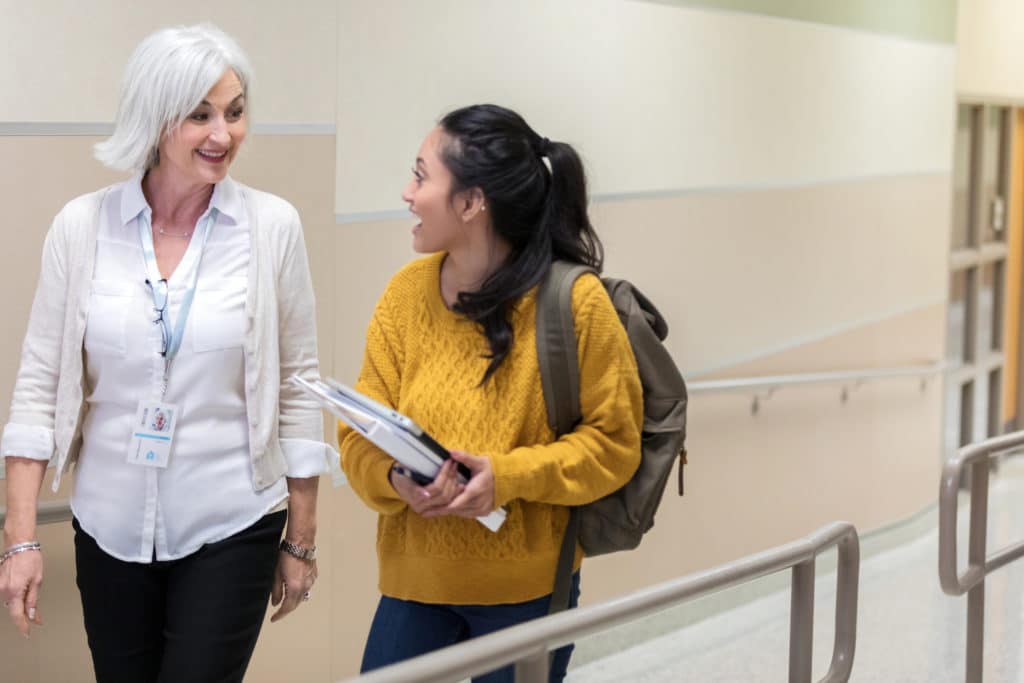A student’s self-image is formed by experiences and relationships—watch any stereotypical high school film, and you’ll see the power of comparisons and social rankings in action. These identifying experiences are the ones that reinforce how students think and feel about themselves. And based on these views, they develop either a positive or negative self-image. So what happens when the image they see is distorted?
K-12 educators can challenge distortions of self-image with social-emotional learning (SEL) strategies that teach adolescents how to develop healthier and more accurate views of themselves. Through restorative curricula, staff can provide students with the tools they need to fully assess their physical, mental, social, and emotional well-being.
What Impacts Student Self-Esteem & Self-Image?
Everyday interactions affect the way students view themselves, others, and the world. For younger generations, including Generations Z and Alpha, the digital era has largely defined these encounters; access to information is now readily available at their fingertips, and digital connectivity is rapidly changing the way students are communicating. Instead of solely depending on lessons learned from direct experiences and in-class learning, students are developing self-image from indirect learning experiences that are largely virtual. For example, the recent need for distanced learning and hybrid models dramatically shifted the way K-12 students were educated in 2020. According to the U.S. Census Bureau, nearly 93% of households with school-aged children reported partaking in some form of virtual learning during the COVID-19 pandemic. The lack of interconnectivity that resulted in this sudden shift is a pattern that deeply affected student self-esteem and self-image, particularly for those students in low-income communities where access to computers and digital devices was limited. As students and staff return to in-person learning, developing social and emotional supports will be an essential part of rebuilding the educational system.
This past year reinforced the importance of viewing learning as a social, emotional, and academic process. Brain research behind this principle has shown that the way students perceive their own abilities is largely influenced by creating connections within a supportive, educational community. If this is the key to effective learning, educational systems recovering from the effects of the pandemic will need to support their staff with tools to recognize and assess the effects of trauma attached to past events. For example, the return to in-person learning will place a lot of emphasis on relationship-centered curricula that focuses on SEL to build better bonds within the educational community. These strategies will help staff in assessing the effects of trauma on students as they return to in-class sessions and address those effects by using an SEL curriculum that supports developing positive self-image in students.
The pandemic also emphasized the growing need for advanced telecommunications capabilities in education, where 31 million devices were provided to K-12 students for use outside of the school. As access to computers, internet service, and digital devices continues to become more available to students in your district, the impact on student self-image will be influenced by:
Evolving Roles in Digital Spaces
Relationships play a big part in the way students form self-image. In a digital age that’s dominated by influencers and activists, adolescents have more opportunities to redefine their social roles and challenge traditional hierarchies. These defined roles are already rapidly changing and extend beyond parental involvement as virtual learning opportunities become more accessible to students. As roles continue to develop in digital spaces, educators will need tools to help K-12 students stay engaged and well-behaved in hybrid classroom environments.
Social Media & Increased Vulnerability to Cyberbullying
Social media is another driving force behind self-image in students. Younger generations communicate and express themselves almost exclusively through digital screens and the shift to remote learning has made telecommunication more accessible to students. What’s more, social media usage has seen an increase of 21% since the pandemic. While social media is helping adolescents develop a sense of individuality within a larger community and has been shown to improve life satisfaction for 70.4% of people, social platforms are also altering the way students seek approval through comparisons—both outcomes, positive or negative, impact self-image. These virtual interactions have also increased student vulnerability to cyberbullying. In fact, K-12 students who are bullied are more likely to have social media accounts, and 94% of teens who had been cyberbullied said that it negatively affected their life.
Body Image
When it comes to navigating self-esteem in the digital era, body image has a lot of sway. Adolescence is a period of extreme vulnerability in students—it’s characterized by major changes in development: social, emotional, intellectual, and physical. Since self-esteem and body image are so closely linked, perceived imperfections can increase levels of stress and influence self-image. The growing reliance on video-conferencing tools and camouflaging programs in social media have further altered body image for students. According to the International OCD Foundation, nearly 10 million people in the United States have body dysmorphic disorder (BDD). For students with BDD, perceived imperfections via social media platforms and online classes can be stressors that affect self-image.
Self-Esteem Activities for Students
Through self-esteem activities that focus on developing core competencies for social-emotional learning (SEL), such as self-awareness, students can learn how to view their substantial and virtual worlds in balance. These tools are designed to help adolescents develop a positive self-image through recognizing their feelings, thoughts, and influences on behaviors. Here are some ways that staff in your district can make a clear commitment to building self-esteem in students:
Cultivate Compassion
Comparisons largely define how adolescents view themselves and others. With access to immediate information, most are introduced to labeled differences daily. The way students view diversity, however, can be challenged. By encouraging self-compassion and compassion for others, they can develop a positive self-image that doesn’t stem from judgment.
Teach Positive Self-Talk
While self-image is impacted by experiences and relationships, it’s also defined by the conscious mind. To coach this invisible voice, students can be taught positive self-talk techniques that can help them become more aware of their values and qualities. This can include lessons on the power of the inner critic, the benefits of using affirmations, and how to assess negative thoughts.
Address Challenges
Practice doesn’t make perfect, and untangling this concept is an important step in developing self-esteem. Students can debunk the myth of perfection by learning more about the goal-setting process and coping strategies for stress and anxiety. With it, educators can help students acknowledge their efforts and celebrate the smaller accomplishments that they put towards achieving larger goals.
Establish Personal & Educational Goals
The failure to meet an unattainable goal can diminish anyone’s self-image. By improving goal-setting skills, students can learn how to manage their expectations without abandoning their ambitions. This is also an important part of establishing a positive growth mindset. Strategies used to establish and work towards these goals include learning how to set realistic goals and sustaining progress towards achievements.
SEL Strategies for Students
For students to benefit from self-esteem activities, their educators must have access to consistent and engaging lesson plans. Social-emotional learning (SEL) curricula offer a great solution for districts. SEL is designed to streamline educational resources for your staff, giving them access to the tools they need to identify, understand, and manage students’ mental and emotional health. Within CASEL’s SEL framework, counselors and educators can use strategies to encourage students to build, assess, and maintain a positive self-image with activities that develop:
- Self-awareness
- Self-management
- Social awareness
- Relationship skills
- Responsible decision-making skills
When delivered in engaging, digital formats, the SEL curriculum has a proven track record for improving student outcomes when it comes to self-image. Suite360—the digital SEL curriculum that Navigate360 offers—features a comprehensive mental health and prevention lesson plan that’s interactive and simple to use. For more information about Suite360 and how it can help students develop a positive self-image in your district, download Why Suite360’s Social-Emotional Learning Is More Important Than Ever today!
This article was originally published on Navigate360.com







